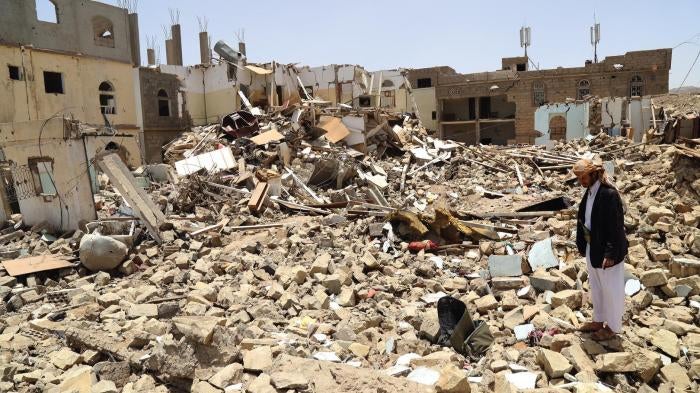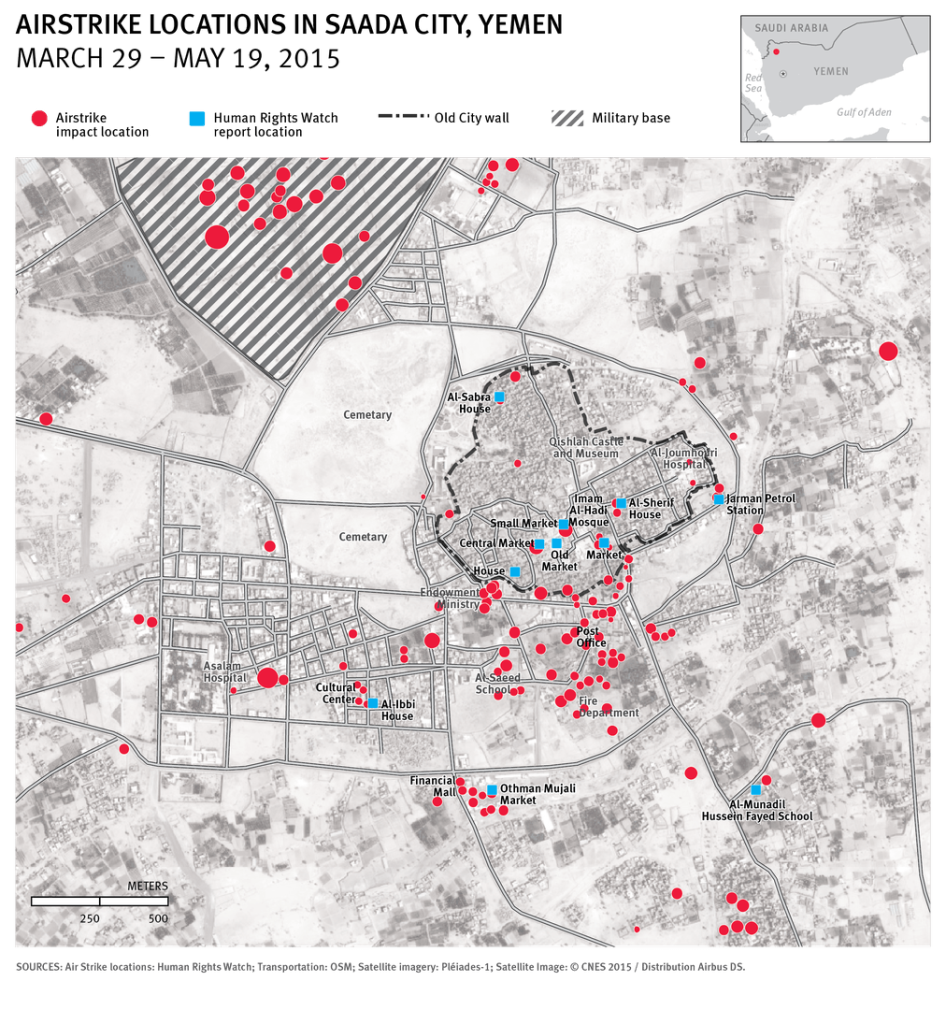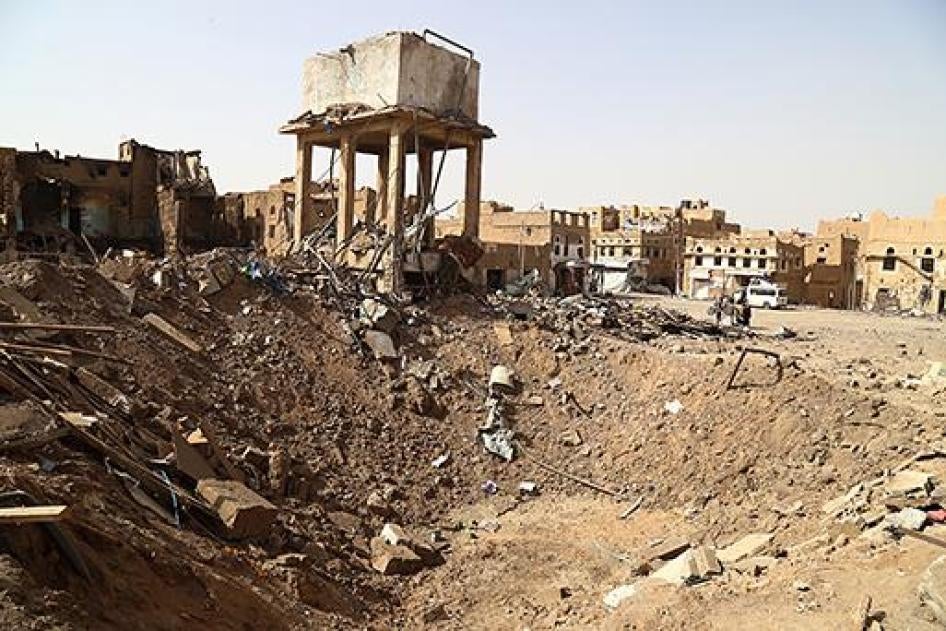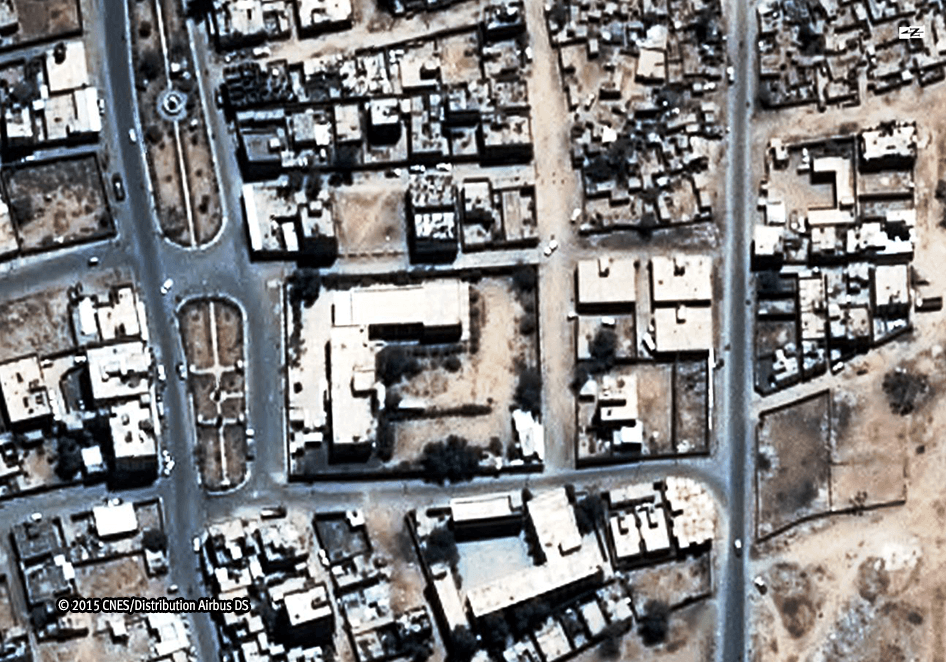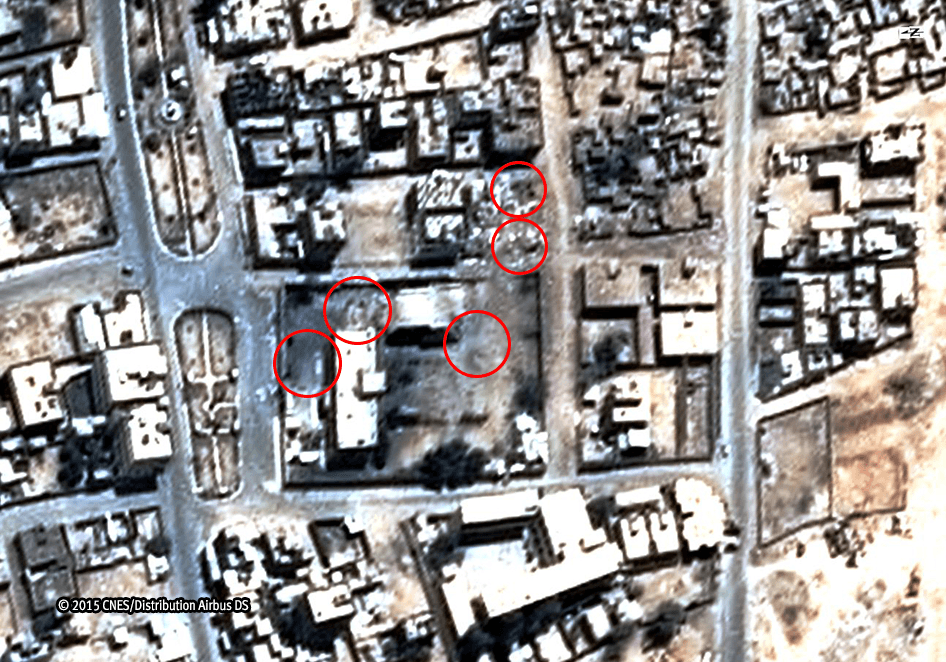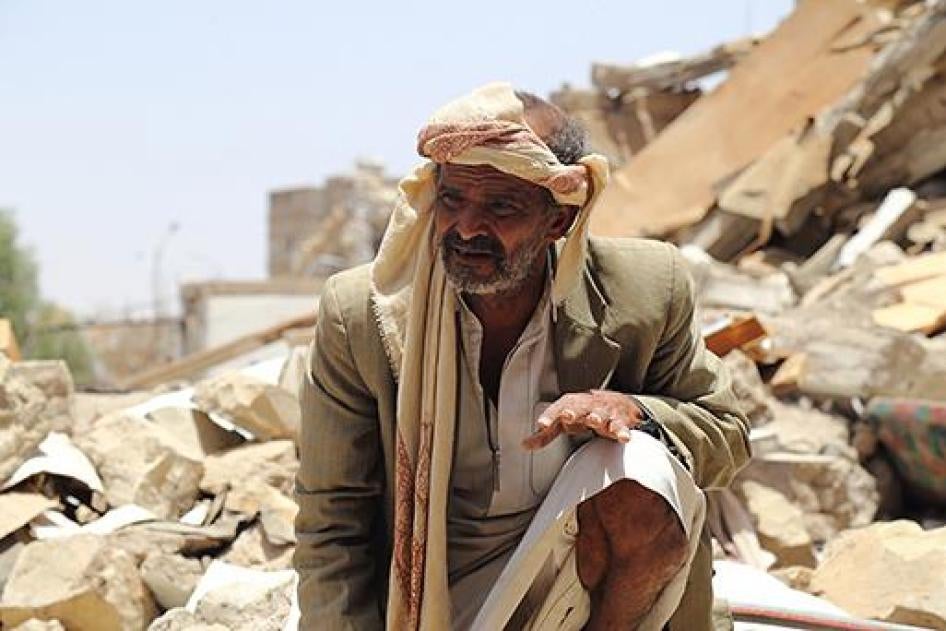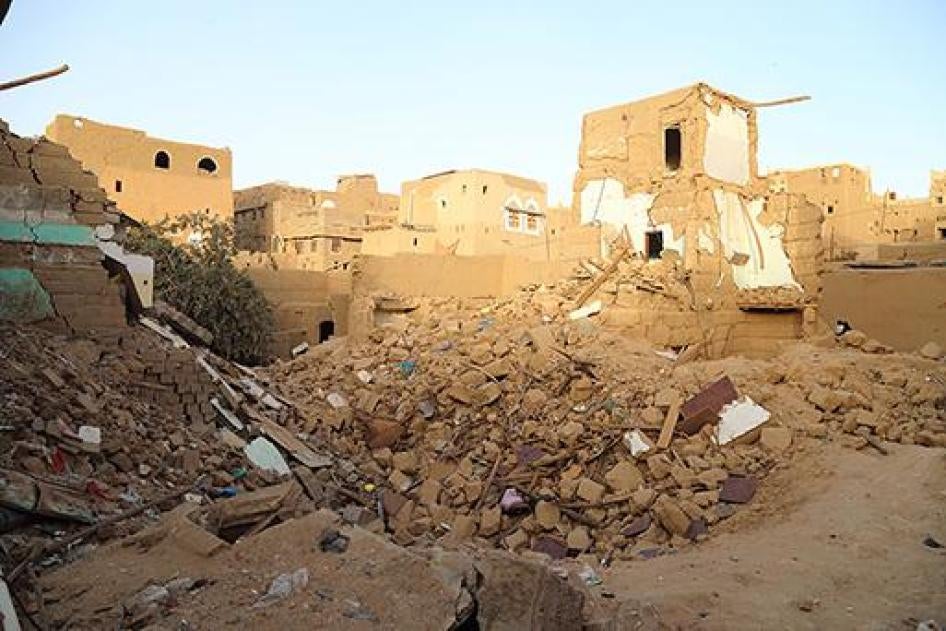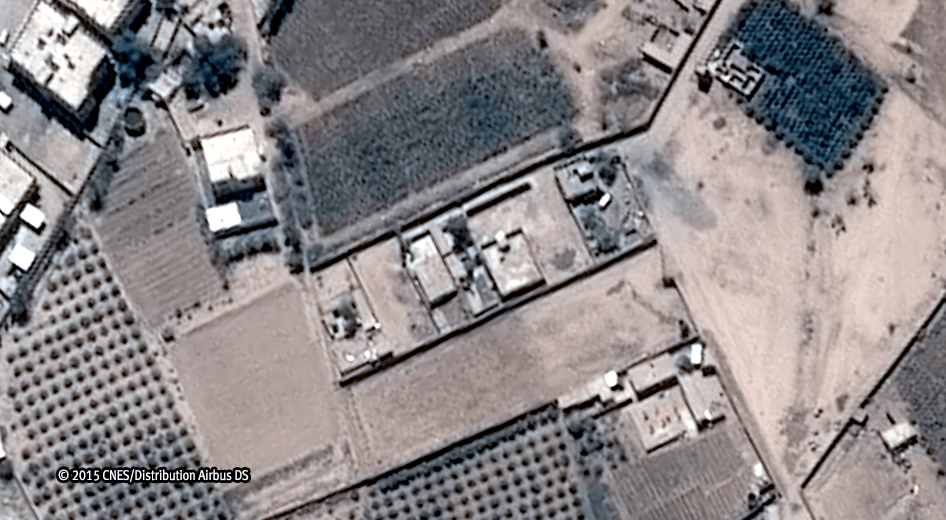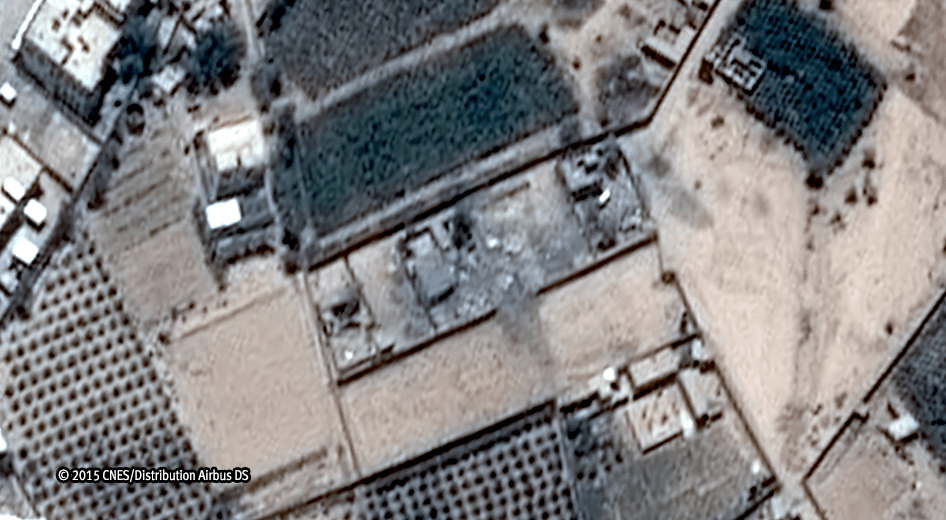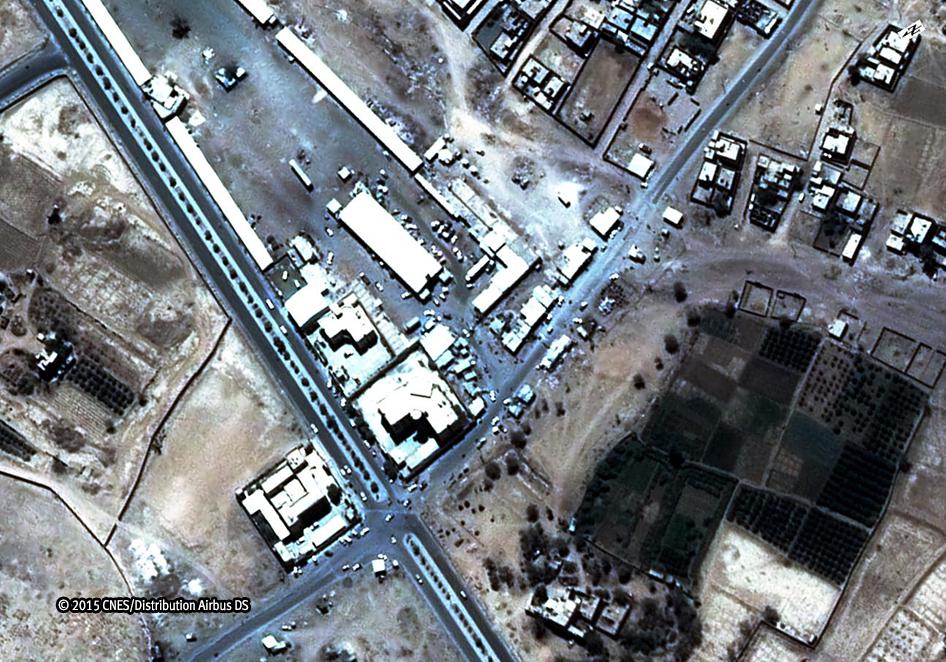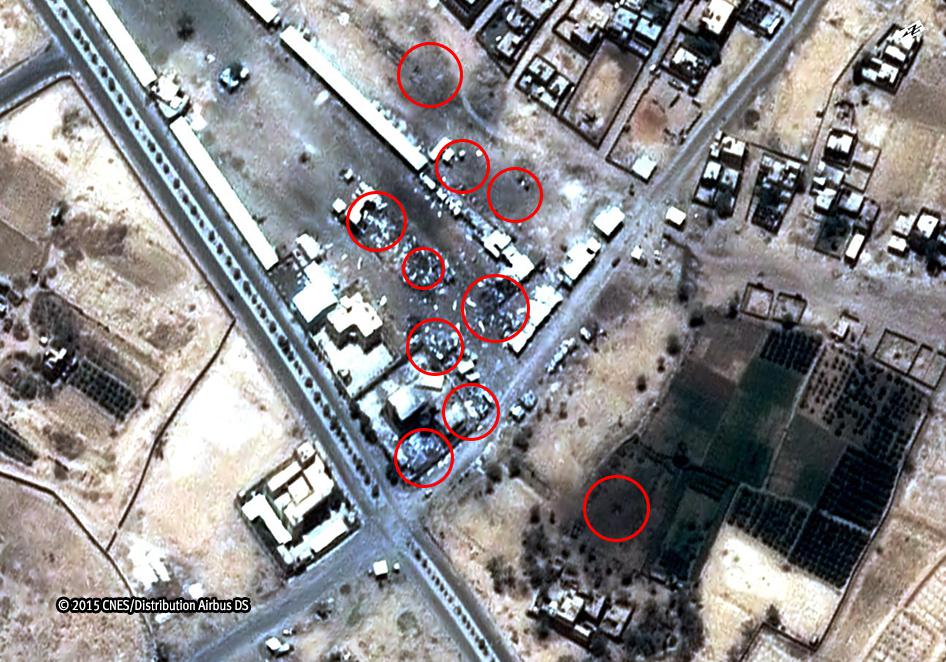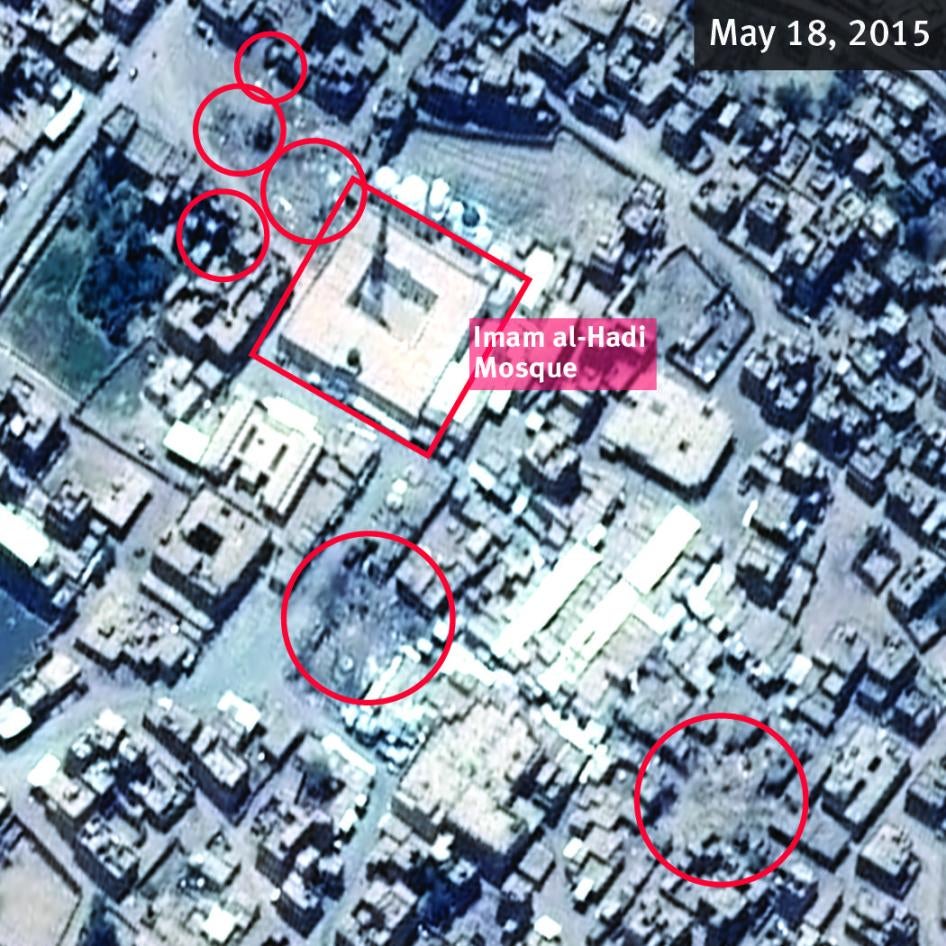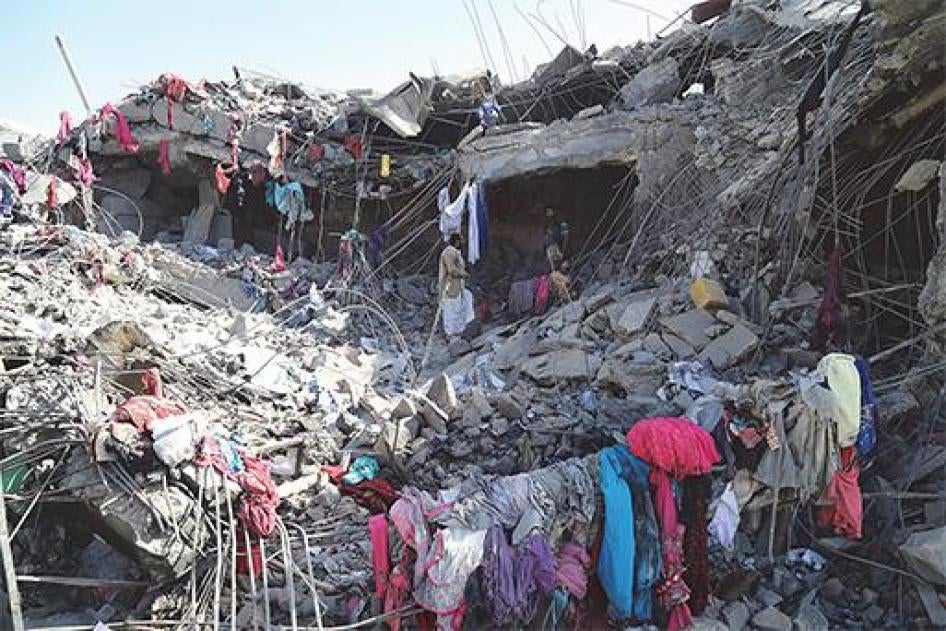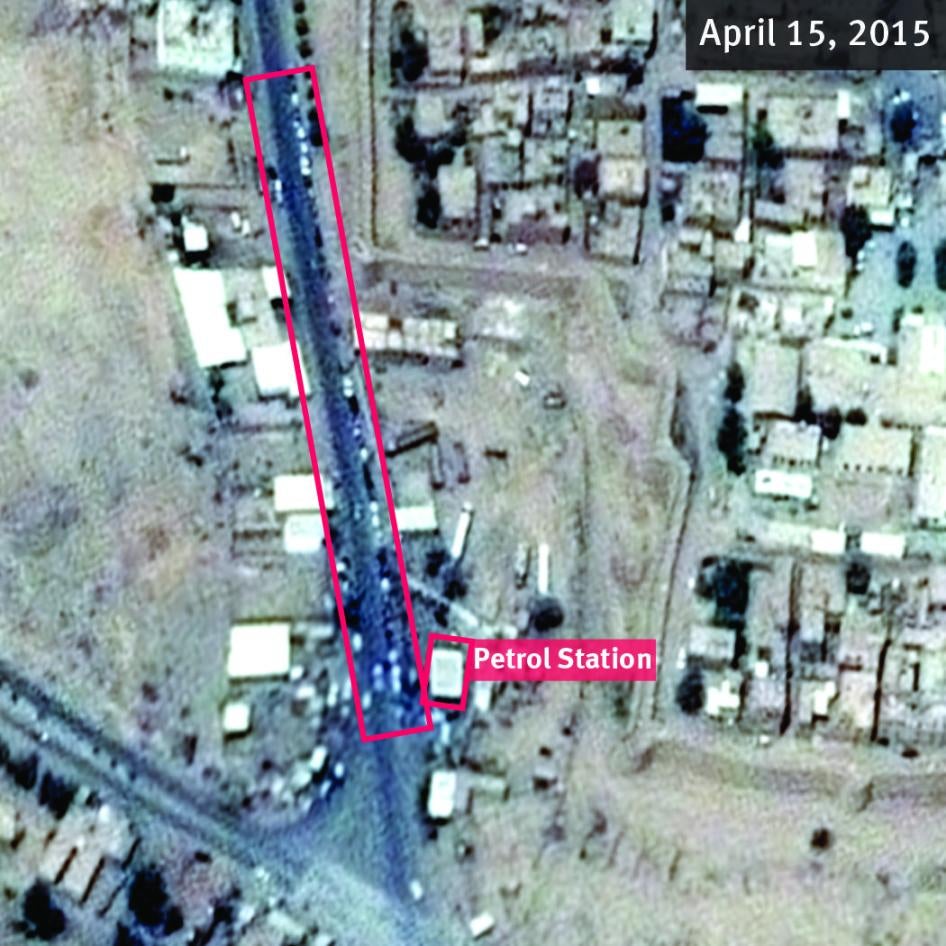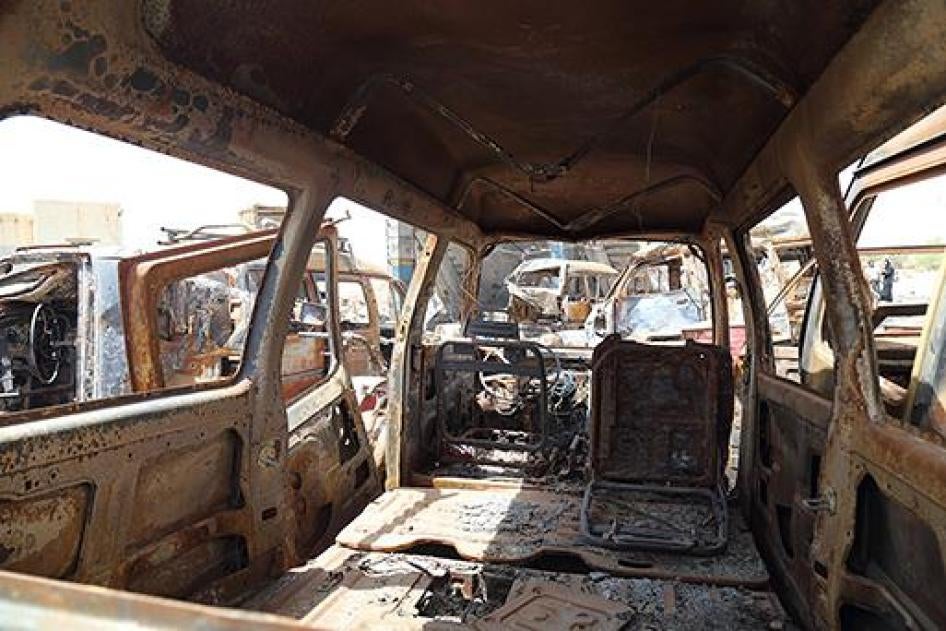Summary
On March 26, 2015, a nine-member coalition of states led by Saudi Arabia began an air campaign in Yemen against the forces of Ansar Allah – commonly known as the Houthis. In the preceding months, the Houthis, a Zaidi Shia armed group from northern Yemen, had taken control of the capital, Sanaa, and swept south threatening to take the port city of Aden.
Coalition airstrikes have targeted a number of cities and towns under the control of the Houthis. One of the places hardest hit has been Saada City, a Houthi stronghold in northern Yemen that is normally home to about 50,000 people. The Saudi Arabia-led coalition has extensively bombed Saada City: satellite imagery shows over 210 distinct impact locations in built-up areas of the city consistent with aerial bombardment. These attacks damaged or destroyed hundreds of buildings.
-->Human Rights Watch conducted field investigations in Saada on May 15 and 16 during a five-day ceasefire, interviewing 28 local residents and examining impact craters and dozens of buildings damaged or destroyed by airstrikes. While many coalition airstrikes were directed at legitimate military targets in the city, Human Rights Watch identified several attacks that appeared to violate international humanitarian law, also known as the laws of war, and resulted in numerous civilian deaths and injuries.
Coalition attacks struck at least six residential houses not being used for military purposes. One attack killed 27 members of a single family, including 17 children. The airstrikes also hit at least five markets for which there was no evidence of military activity. Aerial attacks on an empty school and a crowded petrol station appear also to have violated the laws of war.
Map indicating the locations of the cases described in the report and damages damage overview map
Human Rights Watch investigated each of these incidents by interviewing victims and witnesses to the attack, searching for possible military targets in the vicinity, and obtaining information about victims from medical sources and local authorities.
Human Rights Watch compiled the names and ages of 59 people killed in aerial attacks in Saada City between April 6 and May 11 on the basis of information from relatives, witnesses, medical staff, and local Houthi authorities. These include 14 women and at least 35 children. Human Rights Watch was not able to determine how many of those killed were civilians, but multiple members of the same families were among those killed, including women and children, indicating that many were civilians.
Under the laws of war applicable to the armed conflict in Yemen, civilians and civilian objects may never be deliberate targets of attack. Attacks that fail to discriminate between civilians and combatants or that cause civilian harm disproportionate to the expected military gain of an attack are prohibited. Warring parties are required to take precautionary measures to minimize incidental loss of civilian life, injury to civilians, and damage to civilian objects. This includes avoiding the deployment of forces in densely populated areas.
On May 8, a coalition spokesman announced that the entire city of Saada was a military target. This not only violated the laws-of-war prohibition against placing civilians at particular risk by treating a number of separate and distinct military objectives as a single military target, but possibly also the prohibition against making threats of violence whose purpose is to instill terror in the civilian population.
Human Rights Watch called on all parties to the conflict to abide by international humanitarian law. The coalition should promptly investigate all alleged laws-of-war violations carried out by coalition forces, including those detailed in this report, and provide compensation and other redress to civilian victims as appropriate. Human Rights Watch urged the coalition not to use explosive weapons with wide area effect in populated areas because of the inevitable civilian harm caused. The United States and other coalition supporters should press the coalition to abide by its international legal obligations, and should also investigate alleged violations in any attack where they played a direct role.
Recommendations
To Saudi Arabia and other Coalition Members
- Abide by the laws of war, including the prohibitions on attacks that target civilians, that do not discriminate between civilians and combatants, and that cause civilian loss disproportionate to the expected military benefit.
- Take all feasible precautions to minimize harm to civilians, including making advance effective warnings of attacks when possible.
- Revoke any declaration that particular cities or towns are entirely military targets, and take appropriate disciplinary action against individuals making such declarations.
- Consistent with the prohibition on indiscriminate attacks, end the use of explosive weapons with wide area effect in populated areas.
- Provide prompt and appropriate compensation to civilians and their families for deaths, injuries, and property damage resulting from wrongful strikes. Consider providing “condolence” payments to civilians suffering harm from airstrikes without regard to wrongdoing.
- Conduct transparent and impartial investigations into credible allegations of laws-of-war violations, including the incidents included in this report.
- Institute a policy of conducting investigations into airstrikes in which there were high numbers of civilian casualties even where no evidence suggests violations of the laws of war.
- Make public information on intended military targets in airstrikes that resulted in civilian casualties, and all military actors involved in such strikes.
- Make public the findings of investigations and include recommendations for disciplinary measures or criminal prosecutions where violations are found.
To Houthi Forces
- Abide by the laws of war, including taking all feasible steps to minimize the risks to populations under their control.
- Avoid placing military objectives in densely populated areas and take steps to remove civilians from areas under attack.
To the United States and other Coalition Supporters
- Urge coalition members to implement the recommendations listed above, especially pressing for impartial investigations into airstrikes that allegedly violate the laws of war.
- Conduct investigations into any airstrike alleged to have violated the laws of war and that the US may have directly participated in, either by refueling fighter jets on bombing missions or providing targeting information and other direct support.
To the UN Security Council
- Remind all parties to the conflict in Yemen that anyone responsible for “planning, directing, or committing acts that violate applicable international human rights law or international humanitarian law, or acts that constitute human rights abuses” are potentially subject to travel bans and asset freezes under Resolution 2140.
To President Hadi’s Government
- Urge that the coalition provide detailed information about intended military targets of airstrikes in which civilians died. Make that information publicly available and press for compensation where there is a finding of wrongdoing.
Methodology
This report is based on Human Rights Watch field research in the Yemeni cities of Saada and the capital, Sanaa, in May 2015. Two Human Rights Watch researchers interviewed 28 individuals who had witnessed airstrikes carried out by the Saudi Arabia-led coalition in Saada, including four who lost members of their families in the strikes. Human Rights Watch also interviewed three Ansar Allah officials who were based in Saada throughout the aerial bombardment of the city.
Most interviews took place at the sites of individual airstrikes that witnesses were describing, or in Saada’s two functioning hospitals, al-Salam Hospital and al-Jumhouri Hospital. Human Rights Watch conducted all interviews in Arabic or in English with Arabic translation.
All interviews were voluntary; participants were informed of the purpose of the interview and the way in which their information would be documented and reported, and that they could stop the interview at any time or decline to answer specific questions posed. All participants gave oral consent to be interviewed, and no one received any remuneration for giving an interview.
Human Rights Watch also reviewed official reports on the numbers of those killed and wounded due to airstrikes. These included statistics for the governorate of Saada issued by Yemen’s Houthi controlled Ministry of Health, and a list containing names and other details of 150 killed and 344 wounded in Saada governorate that the Ansar Allah Human Rights Implementation office had compiled. Human Rights Watch also reviewed the medical records of patients admitted to al-Salam Hospital and al-Jumhouri Hospital for injuries caused by alleged coalition airstrikes.
In addition to field research, Human Rights Watch conducted a detailed damage assessment for the town of Saada and surrounding villages using a time series of 11 very high-resolution commercial satellite images recorded between January 6 and May 19, 2015.[1] Satellite imagery was used to identify additional areas of destruction, verify witness statements, and assess the scale, distribution, and timing of airstrikes during a two-month period.
On May 20, 2015, Human Rights Watch wrote to the Saudi Arabian government to seek information on intended targets of 13 of the airstrikes in Saada City that we had investigated.[2] At the time of publication, Human Rights Watch had not received a response to the letter. Any future responses to this report from the Saudi Arabian government will be posted on the Yemen page of the Human Rights Watch website: www.hrw.org.
I. Background
In September 2014, Ansar Allah, known as the Houthis, a Zaidi Shia group from northern Yemen, seized control of Yemen’s capital, Sanaa.[3] They did so with the help of former President Ali Abdullah Saleh, and units of Yemen’s army that remained loyal to him after he stepped down in 2011.[4] In January 2015, the Houthis effectively ousted Yemeni President Abdu Rabu Mansour Hadi and his cabinet, who subsequently relocated to Saudi Arabia and re-established a government there.[5]
In March, after Houthi forces advanced southward, threatening to take the port city of Aden and other areas, a Saudi Arabia-led coalition began aerial military operations against them. On March 26, coalition warplanes began attacks against Houthi forces in several locations, including in Sanaa. The air operations have continued. Between March 26 and June 11, the coalition carried out at least 2,724 airstrikes, according to local human rights organizations who are keeping a tally.[6]
The Saudi Arabia-led coalition comprises five members of the Gulf Cooperation Council (GCC) – Saudi Arabia, Bahrain, Kuwait, Qatar, and the United Arab Emirates – as well as Egypt, Jordan, Morocco and Sudan.[7] According to the GCC states, the coalition launched its military operations at the request of President Hadi, whom they continue to recognize as Yemen’s head of state.[8] The US is not a member of the coalition, but according to the White House, provides “logistical and intelligence support.”[9] On April 12, the Wall Street Journal reported that unnamed US officials had said the US was providing Saudi Arabia with direct targeting support for airstrikes.[10]
Airstrikes have struck alleged Houthi military targets in densely populated areas in the capital, Sanaa, and other cities, including Hodaida, Taiz, Ibb, Lahj, al-Dale`a, Shabwa, Marib, and Aden. Airstrikes were suspended except in Yemen’s border regions during a declared five-day ceasefire on May 12-17, but then resumed on May 18. At the time of publication, airstrikes were continuing.[11]
Human Rights Watch has documented several airstrikes that appear to have been unlawfully indiscriminate, resulting in civilian casualties. These include an airstrike on a camp for internally displaced persons located 16 kilometers south of Yemen’s border with Saudi Arabia that killed at least 29 civilians, and an airstrike on a dairy factory outside the port city of Hodaida, that killed at least 31 civilians.[12]
Human Rights Watch has also documented coalition use of banned cluster munitions in attacks in at least five areas of Saada governorate where civilians reside.[13] We have not seen any evidence to indicate that cluster munitions have been used in Saada City.
Before and since the airstrikes began, the Houthis have conducted ground operations primarily against pro-Hadi Yemeni forces, including a few units of the Yemeni army and the so-called Popular Resistance Committees in the southern cities of Taiz and Aden. Pro-Houthi forces have also carried out operations against Saudi Arabia, including by launching artillery rockets indiscriminately from Saada governorate into the southern Saudi Arabian border city of Najran and areas of Jizan province in May.[14]
Currently, Houthi forces control or are present in much of the western half of Yemen.[15]
According to the United Nation’s Office of the High Commissioner for Human Rights, the fighting in Yemen had killed 1,412 civilians, many as a result of airstrikes, by June 16.[16]
The Houthis in Saada
The current leader of the Houthi movement, Abd al-Malik al-Houthi, and his leadership have historically been based in Yemen’s northern Saada governorate. Since 2004, the Houthis engaged in six separate armed conflicts with the Yemeni government, in which both sides were responsible for serious violations of the laws of war.[17]
The 2011 uprising that led to President Ali Abdullah Saleh, who had held office for 33 years, stepping down resulted in weakened government control of parts of the country including the north. The Houthis became the de facto governing authority in Saada. They appointed a governor, collect taxes, oversee local government, and administer justice.[18]
Saada City, with an estimated pre-war population of 50,000, is a military as well as political Houthi stronghold.
II. Houthi Deployment and the Coalition Declaration of Towns as Military Targets
On May 8, 2015, coalition authorities declared the entire Houthi stronghold cities of Saada and Marran to be military targets. This followed Houthi incursions into and rocket attacks on Saudi Arabia from Saada governorate that killed at least 12 civilians in the Saudi Arabian city of Najran and areas of Jizan province, according to Saudi Arabian government sources.[19] Brig. Gen. al-Assiri, the military spokesman for the coalition, told the media:
Starting today and as you all remember we have declared through media platforms and through the leaflets that were dropped on [Marran and Saada], and prior warnings to Yemeni civilians in those two cities, to get away from those cities where operations will take place. This warning will end at 7 p.m. today and coalitions forces will immediately respond to the actions of these militias that targeted the security and safety of the Saudi citizens from now and until the objectives of this operation are reached.
We have also declared Saada and Marran as military targets loyal to the Houthi militias and as a result the operations will cover the whole area of those two cities and thus we repeat our call to the civilians to stay away from these groups, and leave the areas under Houthi control or where the Houthis are taking shelter.[20]
Several attacks on apparently civilian objects that Human Rights Watch investigated in Saada, including an attack that struck a residential house, two attacks that struck markets, and an attack on a school, took place after the May 8 announcement.
Issuing warning of impending attacks to the civilian population is in line with the obligation under the laws of war to take all feasible precautions to minimize civilian harm, and in particular to provide “effective advance warning” of attacks that may affect the civilian population, so long as circumstances permit.[21] However, the general and vague nature of these warnings would be of little help to civilians in need of greater security.
Even more problematic, and a clear violation of the laws of war, is the coalition assertion that the entire cities of Saada and Marran are military targets. The laws of war prohibit attacks that treat as a single military objective a number of clearly separated and distinct military objectives located in a city, town, village or other area containing a similar concentration of civilians or civilian objects.[22]
Even if individual attacks carried out were in accordance with the laws of war, the coalition statement may be in violation of the prohibition against acts or threats of violence in which the primary purpose was to spread terror among the civilian population.[23]
In Saada City, Human Rights Watch observed Houthi vehicle-mounted anti-aircraft weapons deployed in areas still populated by many civilians. Parties to a conflict are obligated to take all feasible measures to avoid placing military objectives in densely populated areas. They should also move civilians from areas where their forces are deployed to minimize civilian harm. However, the extensive Houthi military deployment in Saada, and reportedly in Marran, did not allow the coalition to treat civilians or civilian objects as military objectives, nor did providing warnings to the population relieve the coalition forces of ensuring that all attacks were on military targets.
III. Use of Explosive Weapons with Wide Area Effect in Populated Areas
Human Rights Watch investigations on the ground and analysis of satellite imagery show that coalition forces dropped or launched aerial munitions extensively on Saada City. The munitions used were explosive weapons with wide area impact.
Human Rights Watch identified from a time series of satellite imagery 210 distinct impact locations in built-up areas of the city consistent with aerial bombardment as of May 19, 2015. The satellite imagery shows that these attacks damaged or destroyed hundreds of buildings.
Human Rights Watch’s on-the-ground investigations confirmed that airstrikes have caused significant damage to buildings, streets and markets around the city. Impact craters and damage to buildings at some sites indicate that coalition forces on several occasions used aerial bombs of at least 1,000 pounds in attacks on the city. Bombs of this size can destroy structures and injure and kill people hundreds of meters from the impact point.
The May 9 attack on the market in front of the Imam al-Hadi mosque, for example, wounded one man who was in his home near the window when a munition struck, completely destroyed about a dozen small shops, and caused significant structural damage to residential houses on both sides of the market. The strike created a six-meter wide crater. Human Rights Watch researchers did not find any weapon remnants at the scene of the attack that would have allowed them to determine the specific weapon used.
At a government building in Saada City, Human Rights Watch photographed the remnants of an MK-83 air-dropped 1,000-pound bomb made in the US.
At the site of other attacks Human Rights Watch saw several explosive remnants of war, but was unable to determine the specific type of weapons used or draw further conclusions based on the remnants alone. Saudi Arabia and other members of the coalition have not disclosed information on the types or quantities of weapons used in the airstrikes.
Human Rights Watch investigated specific attacks that appeared to violate the laws of war because they were indiscriminate or disproportionate. Indiscriminate attacks are those that do not differentiate between civilians and combatants; disproportionate attacks are those that cause civilian loss excessive in relation to the anticipated military gain from the attack. Moreover, as a matter of policy, warring parties should not use explosive weapons with wide area effect in populated areas because of the clear risk to civilians.[24]
IV. Unlawful Airstrikes
Human Rights Watch investigated several coalition aerial attacks in Saada City that appeared to be in violation of the laws of war. On the basis of information from relatives, witnesses, medical staff, and local Houthi authorities Human Rights Watch compiled the names and ages of 59 people killed in aerial attacks in Saada City between April 6 and May 11, including 14 women and at least 35 children.[25]
Coalition airstrikes hit at least six residential houses in Saada City. Human Rights Watch found no evidence that the houses were being used for military purposes. In at least two of these attacks, munitions dropped from coalition aircraft struck the houses more than once, suggesting that they were the intended targets. The evidence from other coalition airstrikes, such as those on Houthi security and government buildings in the city, indicates that coalition warplanes were capable of hitting their intended targets with a certain degree of accuracy. VICE News has documented the use of one type of laser-guided air-dropped bomb in an airstrike on Sanaa on May 1 that killed at least 20 people.[26]
Human Rights Watch cannot exclude the possibility that coalition forces intended to hit other targets when they struck the residential houses. For example, in the deadliest of the attacks on residential houses, which destroyed the al-Ibbi house and killed 27 members of the al-Ibbi family, the warplanes possibly targeted an adjacent cultural center, which was also struck.
The attacks on residential houses altogether killed at least 51 people, including 14 women and 32 children. Human Rights Watch conducted separate interviews with nine victims and witnesses of these attacks, all of whom reported that all of those killed and injured in the attacks on residential houses were civilians. Although Human Rights Watch has not been able to independently verify this, the high proportion of women and children from the same families among the victims indicates that the houses’ residents were primarily civilians. The presence of Houthi combatants or other military objectives would not make the attacks lawful if they were carried out indiscriminately or were disproportionate.
Human Rights Watch also found that coalition aircraft attacked and seriously damaged at least five main markets in Saada City. As with the residential houses, multiple strikes on some of the markets suggest that they were the intended targets. Markets are normally civilian objects and should not be attacked. Human Rights Watch saw no evidence indicating that the markets had been used for military purposes, such as for the storage of significant munitions. The presence of small numbers of fighters or weapons in the market would still likely make any bombing of the market a disproportionate attack.
Human Rights Watch also investigated an attack on a school. During a visit to the school, researchers found no evidence to indicate that the school had been used for military purposes, although they were not able to confirm this definitively.
Local Houthi authorities told Human Rights Watch that coalition aircraft had also struck key civilian infrastructure, including the electricity station, a public company that bottles cooking gas, the main public water works, a private wheat storage facility, a company that bottles mineral water, and a petrol station.
Many and perhaps all of these normally civilian objects may have been contributing to the Houthi military effort, making them legitimate military targets. However, the laws of war prohibit attacks that destroy or render useless “objects indispensable to the survival of the civilian population”[27] or would otherwise have a disproportionate impact on civilians compared to the expected military gain from the attack. Not only are food, water, and medicine crucial to the population, but also electricity and petrol.
Even attacks that have a clear military objective and are otherwise lawful should be carried out in a manner that, as much as possible, minimizes civilian harm. The attack on the petrol station, a legitimate target, did not appear to have been carried out in this manner: it occurred in the middle of the day when a long line of people were present, waiting to fill their vehicles. Those killed included at least five civilians, witnesses said.
Human Rights Watch submitted a list of 13 attacks under investigation to Saudi Arabian authorities on May 20, asking what the intended target was for each attack, what weapon or weapons were used, and what precautions the coalition had taken to minimize civilian harm (See Appendix I).[28] At the time of writing, Human Rights Watch had not received any response to its letter.
Human Rights Watch also documented coalition airstrikes on security buildings and installations and government buildings, which were likely legitimate military targets.
Residential Homes
Al-Sherif House
On the morning of May 10, two bombs struck a residential house and the adjacent street in central Saada City, killing at least five people, including the owner of the house and four neighbors from the Qabas family, the mother and three children. The attack also injured two children from the al-Sherif home.[29]
Ahmed al-Sherif, 38, a watch repairman and the owner of one of the houses that were hit, was still receiving treatment at nearby al-Jumhouri hospital when Human Rights Watch interviewed him five days after the attack. Al-Sherif said that he lost consciousness when the attack happened and that he woke up in the hospital the next day. A metal fragment had cut through his intestines, requiring surgery. The attack also wounded his 7-year-old son Mohammed in the left shoulder and his 12-year-old son Abed in the arm and leg, he said.[30] All three had wounds or bandages consistent with al-Sherif’s description.
Sherif Ahmed, 20, one of al-Sherif’s sons, told Human Rights Watch he was outside the house when the attack struck:
Thankfully my father and two brothers were outside when the first strike hit our house. Luckily my mother and sisters were downstairs, near the back of the house. Five minutes later, a second strike hit the other side of the road. That is how my dad, little sister and brother were wounded.[31]
Human Rights Watch examined the site. Two-thirds of the façade of al-Sherif’s house had been destroyed, leaving the inner rooms exposed. Researchers did not find any munition remnants at the site to indicate the weapon used. A crater about one meter in diameter in the asphalt in front of the house was partially filled with bricks and other debris from the house. There was also significant blast damage to stores on the other side of the street.
Ahmed Al-Sherif died from his injuries on June 3, according to a local Ansar Allah official.[32]
Human Rights Watch did not identify any obvious military targets in the vicinity. Sherif Ahmed said that none of his family members were in the Houthi forces and he was not aware of any members in the Qabas family.
Al-Ibbi House
At about 10:50 p.m. on May 6, at least three aerial bombs struck a cultural center and a residential house in southwest Saada City, killing 28 people (27 from one family), including seven women and at least 17 children, and wounding three men.[33]
Local residents told Human Rights Watch that the first bomb struck the Saada Cultural Center and a few minutes later, a second bomb struck the southwest corner of the al-Ibbi family house, which is located next to the center.[34]
Walid al-Ibbi, 35, the only al-Ibbi family member present to survive the attack without injuries, told Human Rights Watch that when the bomb fell on the southwest corner of the house, the family ran outside and towards the eastern entrance at the back of the house, thinking they would be safer in the back apartment. Minutes later, a third strike, possibly with two bombs, hit the part of the house where the family had taken shelter, al-Ibbi said.[35] He told Human Rights Watch:
Just earlier that evening, a family had come to our house to ask for my daughter’s hand in marriage for their son. Now I have lost my wife and all four of my daughters. I cannot believe that everyone I love is gone.[36]
Al-Ibbi said that only three other members of his family survived the attack. His father, Abdullah, a barber, suffered a dislocated jaw and possible brain damage, his doctors in Sanaa told him. A metal fragment struck his brother Younes above one eye, damaging his optical nerve. Doctors told al-Ibbi that Younes may lose his sight if they operate and remove the fragment. Another brother, Ayman, suffered minor injuries. Al-Ibbi said that he was uninjured because he was standing outside the house when the third strike occurred.[37]
Two neighbors gave Human Rights Watch similar accounts of what happened. Saleh Hussein Daglan, 54, who lives next to the al-Ibbi house, said: “I heard the family as they screamed, I ran outside and saw bodies under the rubble. One son, Murad, was screaming ‘Save me! Save me!’ A big stone was crushing his legs. He died.”[38]
Ayed Ayed Kamil, 55, another neighbor three houses down the street from the al-Ibbi house, told Human Rights Watch:
As the last strikes hit, I ran outside and saw four members of the [al-Ibbi] family lying out on the road, under rubble. Three of Abdullah’s sons were dead but one, Younes, was alive. I saw that his forehead was sliced open. The rest of the bodies were in the house including a one-month-old baby and a pregnant woman.[39]
Ayed Ayed Kamil, a neighbor, sits on the ruins of al-Ibbi house, which was struck in an aerial attack on May 6, 2015. © 2015 Ole Solvang/Human Rights Watch
Kamil told Human Rights Watch that the attack also wounded a man from Yemen’s marginalized muhamasheen community, who later died in the hospital from a fragmentation wound to the back of his neck.[40]
Local residents provided Human Rights Watch with photos of at least 10 children who appeared to be under 10 years of age lying side by side on the floor, apparently lifeless. The residents said the photos were taken right after the strike.
At about 2 a.m. on May 7, another airstrike hit the cultural center next to the al-Ibbi home while local people were still pulling bodies out of the rubble from the earlier strikes, the two neighbors said. This caused the crowd of helpers to immediately disperse. Both men said that they knew of no military targets in the area; they said that the nearest security installation was about two kilometers away.[41]
Human Rights Watch examined satellite images of the airstrikes. Researchers inspected three impact craters on the compound of the cultural center. A crater about one meter in diameter was located at the northern side of the cultural center, right inside the entrance gates. Two bombs appeared to have hit the building itself. The al-Ibbi house had been almost completely reduced to rubble with only part of the back wall and rooms still standing. There was also significant damage to neighboring houses. Human Rights Watch researchers did not find any remnants that could help identify the weapons used in the attacks, but aerial bombs appear to have been used.
The fact that at least three bombs struck the cultural center and that a warplane returned several hours after the main strikes to drop another bomb on the cultural center suggest that the center was the intended target of the attack. Al-Ibbi said that neither his father nor any of his brothers held any role with the Houthis. All of the men in the family, he said, were barbers, working at their family’s two salons in Saada City.
Nabil Ali Jameel, the head of the cultural center, told Human Rights Watch that the center is used for local festivals, theatre pieces, as a library, and to host the local Saada-based Ansar Allah radio station, Massira FM.[42] A radio station used to direct military forces – and not merely report news or make propaganda statements – would be a valid military target, subject to a proportionality analysis. Having listened to some of the radio’s broadcasts, Human Rights Watch did not find evidence that the radio station was being used in that way.
One Saada resident said there were rumors that Houthi forces had used the cultural center as a meeting point, but all others with whom Human Rights Watch spoke did not believe this to be true.[43]
Al-Sabra House
In the early hours of April 15, an airstrike hit a residential house in northwest Saada City, killing four people, a woman and her three children, and wounding three to five people, including two children.
Abd al-Razak Qamis, 34, told Human Rights Watch that he heard many airstrikes during the night of April 14/15. One of the strikes hit the home of his neighbor, Ahsen Mohsen al-Sabra, a shopkeeper, and his family of eight. Qamis told Human Rights Watch:
I heard a plane overhead, and then this loud explosion. I looked out of the window, which had shattered with the explosion, and saw Ahsen jumping out of the window of the second floor of the house, clutching his 10-year-old son. I wanted to run outside but was scared that the aircraft might strike us again if we gathered outside.[44]
After 20 minutes, Qamis felt that it was safe enough to run outside to help the family.
Qamis said that the attack killed al-Sabra’s wife and three of his children.[45] A local resident gave Human Rights Watch photos that included one of the destroyed al-Sabra house and several showing three children who appear under the age of 10 lying, apparently lifeless, on the floor. One photo shows what appears to be a covered, larger body lying next to the children.
Al-Jumhouri hospital records show that three people from the al-Sabra family, including two boys, ages 10 and 12, received treatment at the hospital on April 18. Qamis said that the attack also wounded al-Sabra’s pregnant daughter and a woman in a neighboring house. The Ansar Allah list does not contain information about any Houthi casualties from this attack.
Human Rights Watch visited the impact site on May 15. The strike appeared to have destroyed a significant part of the al-Sabra house and caused damage to two adjacent houses. Bricks and other debris from the house partially filled a large crater in front of the house, about three meters in diameter. Human Rights Watch was not able to identify any potential military targets in the vicinity and did not see any remnants to help identify the type of weapon used.
Other Residential Houses
Human Rights Watch investigated aerial attacks on two additional residential houses, but were not able to interview witnesses to these attacks.
On May 5, an aerial attack struck the house of Muhammed al-Hibbi, killing his wife and all seven children when the roof collapsed on top of them, according to his cousin, Nuh Ahmed al-Hibbi.[46] Human Rights Watch did not visit the impact site, but medical staff corroborated the number of casualties.
Around 12:30 a.m. on April 6, an aerial attack struck the home of Muhammad Daghfal, killing seven members of the family, including four women and two children, according to Muhammad Gahsha, a grave worker who buried the dead.[47] Human Rights Watch visited the ruins of the house, which was located in a rural area about five kilometers from the center of Saada City. An investigator at the Salam hospital confirmed the deaths.[48] Satellite imagery recorded on April 7 shows the complete destruction of the Daghfal house. Satellite imagery shows no other damage in the vicinity.
Ruins of the Daghfal house, which was struck by an aerial attack on April 6, 2015, which killed seven members of the family. © 2015 Ole Solvang/Human Rights Watch
Human Rights Watch also investigated the ruins of a residential house near the old market. An Ansar Allah official told Human Rights Watch that warplanes had struck the house on May 7, killing one civilian and wounding two others, but Human Rights Watch was not able to corroborate the number of casualties. Satellite imagery shows that the house was destroyed in the period between May 4 and 10.
Markets
Coalition warplanes attacked and destroyed at least five markets in Saada City, two of them after the coalition announcement that the entire city was a target.[49] Attacks on multiple markets and the absence of evident military objectives in close vicinity to the markets suggest that the markets were the intended targets of the strikes.
Market Opposite the Imam al-Hadi Mosque
Coalition airstrikes hit the fountain and market outside the Imam al-Hadi mosque’s eastern gate in Saada City. The strike likely took place in the morning on May 9.[50] Local people told Human Rights Watch that the mosque had been closed and unavailable for prayer since March 26, the beginning of the coalition air campaign.
Ali Mahmoud al-Hamoud, 22, a laborer, told Human Rights Watch that he was at the gate of the mosque in the morning when he heard an airplane overhead. Then a bomb hit the fountain in the square in front of the mosque, which is surrounded by a small market with about a dozen shops. He fled but heard several more strikes hit the same area about 15 minutes later.[51]
Talal al-Aizug, 28, a security officer living next door to the mosque, said he was at home with his family when the first strike hit. He told Human Rights Watch that he had heard an airplane flying overhead since 7 a.m. He heard strikes in the far distance earlier, and then a massive explosion as a bomb hit the market in front of his house. Fragments and debris flew through the window of the second floor of his home, into the room he was sitting in, lacerating his head and the side of his chest, and broke through the walls at the corner of the house. He showed Human Rights Watch the injuries he had sustained.[52]
The attack destroyed the fountain and all of the shops, and left a crater about three meters deep and six meters in diameter.
When Human Rights Watch visited the site researchers observed that the Houthis had posted armed guards at the entrance to the mosque. However, the presence of armed guards would not render the mosque a military target. Dropping multiple bombs on guards near a market appears unlawfully indiscriminate or disproportionate.
Human Rights Watch reviewed satellite imagery recorded on the morning of May 10 and identified four probable impact locations from separate air-dropped munitions on this market and immediately adjacent buildings on either side of the market. Human Rights Watch found no evidence of any military objective in the immediate area.
Old Market
Ali al-Hashhoush, a shopkeeper in the Old Market located in the center of Saada City, told Human Rights Watch that he was at home, a short walk from his shop, when he heard two loud explosions around midnight. About 10 minutes later he heard a third explosion, and about 10 minutes after that, a fourth. After the fourth, he heard a plane overhead. He said:
I ran towards the noise, and saw the market in ruins. I saw one man with a piece of metal in his neck, his leg was almost cut off from the explosion and half of his left hand had been sliced off. I ran past him to the second man. He was an older man that I knew well, very poor, who used to sleep in the market. I picked him up so he could be driven to the hospital – blood was pouring out of his head, down his chest. He died hours later. I saw a third man, but I am not sure what happened to him. Others carried him out of the rubble and he was also wounded.[53]
The strike likely occurred on May 10.[54]
Human Rights Watch reviewed satellite imagery recorded in the morning of May 19 and identified a large zone of complete destruction, approximately 30 by 40 meters in size, within the Old Market resulting from impact of one and possibly more air-dropped munitions. Human Rights Watch found no evidence of any military objective in the immediate area.
Human Rights Watch also visited the ruins of a small outdoor market outside Jarman Commercial Market that coalition aircraft attacked on the night of April 15, according to local people, but was unable to interview witnesses to the strike. Satellite imagery shows that the strike took place between the mornings of April 14 and 15.
Human Rights Watch also visited the ruins of the central market located next to the Religious Endowments Ministry. Satellite imagery shows that two attacks struck the market in the period April 7-14, one attack struck on April 14-15, and at least one attack struck in the period May 4-10. According to two men who had shops there, one of the strikes, probably the one on April 14-15, killed a shopkeeper.[55]
The two shopkeepers said another strike hit the building of the Religious Endowments Ministry, which also housed a restaurant, juice shop, and small grocery store, on the night between May 9 and 10. No one was wounded in the strike because it happened at night, they said.[56]
Satellite imagery also shows the destruction of the Othman Mujali Market in the southern part of Saada City. The main market building was destroyed between April 15 and May 2. At least eight aerial bombs were dropped on the remaining market buildings and the adjacent financial building. According to Al-Jumhouri hospital records, the strikes killed two civilians and wounded nine.
Ansar Allah officials told Human Rights Watch that airstrikes had damaged three other markets on the outskirts of the city, the agricultural products market, al-Khafji Market, and Talh market.
Al-Munadil Hussein Fayed School
A coalition airstrike hit al-Munadil Hussein Fayed School, a girls’ secondary school in Saada City at 8:30 a.m. on May 11. Abdulhaliq al-Mutamayiz, 32, who lives 100 meters away, told Human Rights Watch that he was walking past the school when one corner of it sustained an aerial strike, leading him and another man to run for cover behind a nearby wall. From there, al-Mutamayiz said he heard another strike three minutes later that hit an open area about 200 meters away, followed by a third strike further away three minutes after that. He said he did not know whether there were any military installations or Houthi fighters at the school. Human Rights Watch’s investigations did not find any evidence that fighters had been using the school.
All education in Yemen has been suspended since March 26, when the coalition air campaign began, and no one was present at the school at the time of the strike, local residents told Human Rights Watch.
A neighboring landowner, Muhammad Ali Saleh, showed Human Rights Watch a deep crater around one meter in diameter in the middle of his field, which he said was made by an aerial munition that burrowed deep into the ground when the school was hit in the strike. Saleh said that the munition was still buried in the ground.
Jarman Petrol Station
On April 15, at least one aerial bomb struck the Jarman petrol station in western Saada City, killing at least five people and injuring 23 – though likely many more -- who were waiting in line to fill their cars with gasoline.
Abed Abd al-Rahman Ali, 23, a car mechanic, told Human Rights Watch that about 50 cars were lined up outside the petrol station, known as the Jarman Station, next to his workshop.[57] The combined effect of the war and the coalition blockade had created long lines at petrol stations all over Yemen.[58]
Ali said he heard an airplane overhead at about 1 p.m. and then a loud explosion. A bomb had hit the gas station’s roof, causing it to collapse in a fireball that incinerated some of the vehicles. Ali, who said he ran out to help the wounded, described a chaotic scene at the station: “I saw four sets of limbs completely severed so we don’t know who they belonged to.”[59]
Ansar Allah’s civil affairs office provided Human Rights Watch the names of five people who died in the attack and 23 wounded. Medical personnel told Human Rights Watch that they were not able to identify eight people after the attack because they were too badly burned, indicating a higher casualty figure.
Witnesses described seeing many victims after the attack. Ali said that he saw about 15 to 20 bodies on the ground and about 20 to 25 people with burns and fragmentation wounds. His brother, Osamah Abd al-Rahman Ali, told Human Rights Watch he arrived at the scene minutes after the strike and saw at least eight bodies, including some with severed limbs, and 16 wounded.
Human Rights Watch was also not able to establish how many of those killed were civilians. The Ansar Allah civil affairs office told Human Rights Watch that the people whose deaths they had documented were all civilians.[60] Ali told Human Rights Watch that he did not see anybody at the station carrying weapons. Another Saada resident, however, told Human Rights Watch that the Houthis used the Jarman petrol station as the main one at which to refuel their vehicles.[61]
Satellite imagery recorded around 10:30 a.m. on April 15, about two and a half hours before the airstrike, shows a line of several dozen vehicles stretching approximately 175 meters from the petrol station.[62] The vehicles appear small in size consistent with passenger cars and pickup trucks. Satellite imagery recorded on May 2 shows extensive building destruction and fire-burned cars surrounding the petrol station consistent with the detonation of aerial munitions and secondary fuel tank fires.
During its investigation of the site, Human Rights Watch found that the concrete overhang above the petrol pumps had collapsed, consistent with witnesses’ claims that a bomb struck the roof. There were seven burned-out vehicles in close proximity to the station. All of the vehicles appeared civilian. Five of the vehicles were small passenger mini-buses. Two cars were regular personal cars. Photos from the immediate aftermath of the attack that Human Rights Watch reviewed do not show any additional vehicles that would appear to be military.
Because of the importance of fuel for military operations, depriving belligerent forces of fuel supplies is a legitimate military objective. Even so, for the coalition to attack a petrol station in the middle of the day when it could reasonably be determined that many civilians were present, instead of at night and after providing a specific warning, is contrary to the obligations to take all feasible precautions to minimize civilian harm and may amount to an unlawfully indiscriminate or disproportionate attack.
V. Applicable International Humanitarian Law
International humanitarian law, also known as the laws of war, applies to the armed conflict between the Saudi Arabia-led coalition and Houthi forces.
The fundamental tenets of the laws of war are civilian immunity from attack and distinction. While humanitarian law recognizes that some civilian casualties are inevitable, it imposes a duty on warring parties at all times to distinguish between combatants and civilians, and to target only combatants and other military objectives.
Civilian objects are those that are not considered military objectives.[63] Military objectives are combatants, including civilians directly participating in the hostilities, and those objects that “by their nature, location, purpose or use, make an effective contribution to military action and whose total or partial destruction, capture or neutralization, in the circumstances ruling at the time, offers a definite military advantage.”[64]
In general, the law prohibits direct attacks against what are by their nature civilian objects, such as homes and apartments, places of worship, hospitals, schools, or cultural monuments, unless they are being used for military purposes.[65]
Deliberate, indiscriminate, or disproportionate attacks against civilians and civilian objects are prohibited. Attacks are indiscriminate when they are not directed at a specific military objective, or employ a method or means of warfare that cannot be directed at a military objective or whose effects cannot be limited.[66] It is also prohibited as an indiscriminate attack to treat as a single military objective a number of clearly separated and distinct military objectives located in a city, town, village or other area containing a similar concentration of civilians or civilian objects.[67] Threatening such attacks may amount to acts in which the primary purpose is to spread terror among the civilian population.[68]
A disproportionate attack is one in which the expected incidental loss of civilian life and damage to civilian objects would be excessive in relation to the concrete and direct military advantage anticipated.[69] The expected danger to the civilian population and civilian objects depends on various factors, including their location (possibly within or near a military objective), the accuracy of the weapons used (depending on the trajectory, the range, environmental factors, the ammunition used, etc.), and the technical skill of the combatants (which can entail random launching of weapons when combatants lack the ability to aim effectively at the intended target).[70]
In the conduct of military operations, parties to a conflict must take constant care to spare the civilian population and civilian objects from the effects of hostilities.[71] Parties are required to take precautionary measures with a view to avoiding, and in any event minimizing, incidental loss of civilian life, injury to civilians, and damage to civilian objects.[72]
Before conducting an attack, a party to the conflict must do everything feasible to verify that the persons or objects to be attacked are military objectives and not civilians or civilian objects.[73] According to the International Committee of the Red Cross (ICRC) the requirement to take all “feasible” precautions means, among other things, that those conducting an attack are required to take the steps needed to identify the target as a legitimate military objective “in good time to spare the population as far as possible.”[74] They also must take all feasible precautions in the choice of means and methods of warfare to minimize loss of civilian life and property.[75]
The laws of war do not prohibit fighting in urban areas, although the presence of civilians places greater obligations on warring parties to take steps to minimize harm to civilians. Forces must avoid locating military objectives within or near densely populated areas, and endeavor to remove civilians from the vicinity of military objectives.[76] Belligerents are also prohibited from using civilians to shield military objectives or operations from attack. "Shielding" refers to purposefully using the presence of civilians to render military forces or areas immune from attack.[77] The unlawful deployment of forces within or near densely populated civilian areas does not relieve opposing forces from taking into account the risk to civilians when conducting attacks. The obligation to respect the laws of war does not depend on reciprocity by belligerent forces.[78]
Human Rights Watch opposes the use of aerial bombs and other explosive weapons with wide area effect in populated areas due to the inevitable civilian harm caused.
Individuals who commit serious violations of international humanitarian law with criminal intent are responsible for war crimes. Criminal intent has been defined as violations committed intentionally or recklessly.[79] Individuals may also be held criminally liable for attempting to commit a war crime, as well as assisting in, facilitating, aiding, or abetting a war crime. Responsibility may also fall on persons planning or instigating the commission of a war crime.[80] Military commanders and civilian leaders may also bear personal responsibility as a matter of command responsibility if they knew or should have known about the commission of war crimes and failed to prevent them or punish those responsible.
Those acts considered to be war crimes can be found in customary law as reflected in the Rome Statute of the International Criminal Court (ICC) and other sources. They include a wide array of offenses, including deliberate, indiscriminate, and disproportionate attacks harming civilians, and mistreatment of persons in custody.[81]
VI. Acknowledgements
This report was researched and written by Belkis Wille, researcher for the Middle East and North Africa division, and Ole Solvang, senior researcher in the Emergencies division at Human Rights Watch.
Malcolm Smart, editor with the Middle East and North Africa division, and Tom Porteous, deputy program director, edited the report. James Ross, legal and policy director, provided legal review. Mark Hiznay, senior researcher in the Arms division, Josh Lyons, satellite imagery analyst, Bede Sheppard, deputy director of the Children’s Rights division, and Adam Coogle, Middle East and North Africa researcher, provided specialist review.
Middle East and North Africa associate Sandy Elkhoury provided production assistance. Kathy Mills, publications specialist and Fitzroy Hepkins, administrative manager, prepared the report for publication.
Appendix I: Human Rights Watch Letter to the Minister of Defense His Royal Highness Mohammad bin Salman Al Sa`ud
May 20, 2015
His Royal Highness Mohammad bin Salman Al Sa`ud
Minister of Defense
Ministry of Defense
Riyadh, Kingdom of Saudi Arabia
Your Royal Highness,
Human Rights Watch has been conducting research into alleged violations of the laws of war by all parties to the armed conflict in Yemen, including Coalition forces, Ansar Allah (the Houthis), and other armed groups. Our recent research includes a number of airstrikes by Coalition forces that struck the city of Saada and killed and wounded civilians or damaged civilian property.
To help us understand whether these attacks were carried out in accordance with the laws of war, we would appreciate responses to the following questions with regard to each of the attacks listed in the attachment.
- What was the intended target of the attack?
- What weapon or weapons were used in the attack?
- What precautions were taken to minimize civilian harm?
Any other information you can provide on any of these incidents, including whether you are conducting an investigation into possible laws-of-war violations, would be appreciated.
To meet our publication schedule, we would need to receive a response from you by May 27 so that your answers and comments can be reflected in our reporting.
Thank you for your consideration. We look forward to your response and stand ready to discuss with you our findings.
Sincerely,
Joe Stork
Deputy Director
Middle East and North Africa Division
Human Rights Watch
Aerial Attacks in Saada under Human Rights Watch Investigation
1. Date: May 11; Time: 8:30 am; Latitude: 16°55'51.58"N; Longitude: 43°46'15.98"E.
2. Date: May 9; Time: 10:30-11 am; Latitude: 16°56'19.56"N; Longitude: 43°45'56.15"E.
3. Date: May 9 or 10; Time: night; Latitude: 16°56'13.71"N; Longitude: 43°45'41.61"E.
4. Date: May 10; Time: midnight; Latitude: 16°56'19.50"N; Longitude: 43°45'47.82"E.
5. Date: May 9; Time: Early morning; Latitude: 16°56'8.73"N; Longitude: 43°44'59.98"E.
6. Date: May 10; Time: 8 am; Latitude: 16°56'24.54"N; Longitude: 43°45'58.09"E.
7. Date: May 7; Time: 10 am; Latitude: 16°56'16.30"N; Longitude: 43°45'44.96"E.
8. Date: May 5; Time: Evening; Latitude: 16°56'0.58"N; Longitude: 43°45'27.43"E.
9. Date: April 15; Time: night; Latitude: 16°56'14.43"N; Longitude: 43°45'41.91"E.
10. Date: April 15; Time: 2 am; Latitude: 16°56'36.98"N; Longitude: 43°45'42.79"E.
11. Date: April 15; Time: night; Latitude: 16°56'21.71"N; Longitude: 43°45'51.15"E.
12. Date: April 15; Time: 1 pm; Latitude: 16°56'25.28"N; Longitude: 43°46'10.24"E.
13. Date: April 6; Time: 12:30 am; Latitude: 16°57'2.41"N; Longitude: 43°42'52.02"E.
Times are indicated in UTC +3:00. Impact coordinates are presented in the dd.mm.ss.sss format and were recorded with a civilian GPS unit (WGS84).
